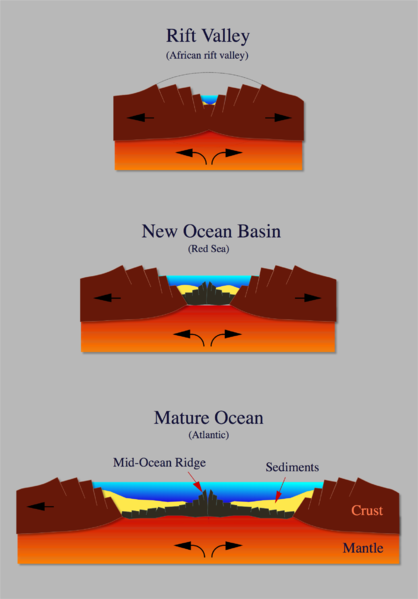EXPLORE: Theory of Plate Tectonics
Completion requirements
View
.
3. READ: Harry Hess
By the early 1960s, reasonably accurate maps of the ocean floor became available. The maps showed a strange geology. Down the middle of the oceans ran a volcanic mountain range that wound around the earth like the seams of a baseball. This mid-ocean ridge, as it was called, was a place of high heat flow and showed signs of continual underwater eruptions of magma and lava. Rock on the ocean floor was very young compared to the rock of the continents. It appeared that new ocean floor was being created in the mid-ocean ridge region. How could these facts be explained?
Harry Hess, a professor of geology at the Princeton University, and others suggested an idea that they called seafloor spreading. They proposed that the ocean floor was splitting open. Magma from within the earth would rise and fill the fissures created by the splitting motion. This magma would harden into young ocean rock. The process would repeat, creating new ocean floor each time the floor split. In time, the ocean floor would grow wider and wider.

If the Earth's crust was expanding along the oceanic ridges, Hess reasoned, it must be shrinking elsewhere. He suggested that new oceanic crust continuously spread away from the ridges in a conveyor belt-like motion. Many millions of years later, the oceanic crust eventually descends into the oceanic trenches -- very deep, narrow canyons--that occur at convergent plate boundaries along the rim of the Pacific Ocean basin. According to Hess, the Atlantic Ocean was expanding while the Pacific Ocean was shrinking. As old oceanic crust was consumed in the trenches, new magma rose and erupted along the spreading ridges to form new crust. In effect, the ocean basins were perpetually being "recycled," with the creation of new crust and the destruction of old oceanic lithosphere occurring simultaneously.
The theory of seafloor spreading explains how new ocean crust is formed at ocean ridges and destroyed at deep ocean trenches (the next page shows an animation of what this looks like). Thus, Hess' ideas neatly explained why the Earth does not get bigger with sea floor spreading, why there is so little sediment accumulation on the ocean floor, and why oceanic rocks are much younger than continental rocks.
Source
http://pubs.usgs.gov/gip/dynamic/historical.html (public domain)
http://pubs.usgs.gov/gip/dynamic/developing.html (public domain)
Harry Hess, a professor of geology at the Princeton University, and others suggested an idea that they called seafloor spreading. They proposed that the ocean floor was splitting open. Magma from within the earth would rise and fill the fissures created by the splitting motion. This magma would harden into young ocean rock. The process would repeat, creating new ocean floor each time the floor split. In time, the ocean floor would grow wider and wider.

Diagram of Rift Valleys and the creation of new ocean crust at divergent plate
boundaries. Picture courtesy of Wikimedia. Licensed CC BY-SA.
If the Earth's crust was expanding along the oceanic ridges, Hess reasoned, it must be shrinking elsewhere. He suggested that new oceanic crust continuously spread away from the ridges in a conveyor belt-like motion. Many millions of years later, the oceanic crust eventually descends into the oceanic trenches -- very deep, narrow canyons--that occur at convergent plate boundaries along the rim of the Pacific Ocean basin. According to Hess, the Atlantic Ocean was expanding while the Pacific Ocean was shrinking. As old oceanic crust was consumed in the trenches, new magma rose and erupted along the spreading ridges to form new crust. In effect, the ocean basins were perpetually being "recycled," with the creation of new crust and the destruction of old oceanic lithosphere occurring simultaneously.
The theory of seafloor spreading explains how new ocean crust is formed at ocean ridges and destroyed at deep ocean trenches (the next page shows an animation of what this looks like). Thus, Hess' ideas neatly explained why the Earth does not get bigger with sea floor spreading, why there is so little sediment accumulation on the ocean floor, and why oceanic rocks are much younger than continental rocks.
Source
http://pubs.usgs.gov/gip/dynamic/historical.html (public domain)
http://pubs.usgs.gov/gip/dynamic/developing.html (public domain)
